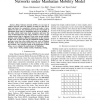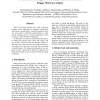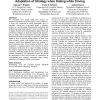26354 search results - page 165 / 5271 » How we refactor, and how we know it |
PIMRC
2010
IEEE
13 years 8 months ago
2010
IEEE
Delay Tolerant networks (DTNs) are one type of wireless networks where the number of nodes per unit area is small and hence the connectivity between the nodes is intermittent. In t...
WEBI
2010
Springer
13 years 8 months ago
2010
Springer
Web 2.0 provided internet users with a dynamic medium, where information is updated continuously and anyone can participate. Though preliminary analysis exists, there is still lit...
Publication
Because of the distance between the dispersed development
locations, Global Software Engineering (GSE) is confronted
with challenges regarding communication, coordination
and co...
CHI
2009
ACM
14 years 11 months ago
2009
ACM
We investigate how people adapt their strategy for interleaving multiple concurrent tasks to varying objectives. A study was conducted in which participants drove a simulated vehi...
ICS
2010
Tsinghua U.
14 years 8 months ago
2010
Tsinghua U.
Computation in the physical world is restricted by the following spatial locality constraint: In a single unit of time, information can only travel a bounded distance in space. A ...



